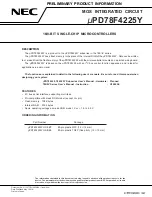
R
Page 4
TG69B
Basic Troubleshooting
1. Inspect charging system components for damage.
Check connections at B– cable, B+ cable, and regulator
harness. Check regulator terminal wiring from regulator
to vehicle components. Repair or replace any damaged
component before electrical troubleshooting.
2. Inspect vehicle battery connections. Connections must
be clean and tight.
Preliminary Check-out
Check symptoms in Table 1 below and correct if necessar
y.
Required Tools and Equipment
Identification Record
Enter the following information in the spaces provided
for identification records.
Alternator model number:
Regulator model number:
Voltage setpoints listed on regulator:
TABLE 1: Preliminary Charging System Check-Out
CONDITION:
CHECK FOR:
Low Voltage
Output
Low battery state of charge.
Load on system exceeds rated out-
put of alternator.
Faulty wiring or poor ground path.
Faulty alternator or regulator.
Wrong regulator installed.
Wrong pulley installed.
Power-limiting feature activated (see
page 6, chart 3).
High Voltage
Output
Faulty regulator.
Faulty alternator.
No Voltage
Output
No energize signal at IGN terminal
on regulator.
Faulty alternator B+ terminal
connection.
Faulty alternator or regulator.
•
Digital Multimeter (DMM)
•
Ammeter (digital, inductive)
•
Jumper wires
3. Determine battery type, voltage, and state of charge.
Batteries must be all the same type. If batteries are
discharged, recharge or replace batteries. Electrical
system cannot be properly tested unless batteries
are charged 95% or higher. See page 1 for details.
4.
Connect meters to alternator:
•
Connect DMM red lead to alternator B+
terminal.
•
Connect DMM black lead to alternator B–
terminal.
•
Clamp inductive ammeter onto B+ cable.
5. Operate vehicle and observe charge voltage.
Charge voltage should increase and charge amps
should decrease. Battery is considered fully charged
when charge voltage is at regulator setpoint and
charge amps remain at lowest value for 10 minutes.
If voltage is at or below regulator setpoint, allow
charging system to operate for several minutes to
normalize operating temperature. If charge voltage
does not increase within 10 minutes, go to Chart 1
on page 5.
CAUTION
If voltage exceeds 46 V, shut down
system immediately.
Damage to
electrical system may occur if
charging system is allowed to op-
erate above 16 V for more than 3
seconds.
Check for OVCO Condition
•
Shut down vehicle and restart engine. If alternator
functions normally after restart, a no output condition
was normal response of voltage regulator to high
voltage condition.
•
Inspect vehicle electrical system, including loose
battery cables. If battery disconnects from system, it
could cause high voltage condition in electrical
system, causing OVCO circuit to trip.
•
If you have reset alternator once, and electrical
system returns to normal charge voltage condition,
there may have been a one time, high voltage spike,
causing OVCO circuit to trip.
•
If OVCO circuit repeats cutout a second time in short
succession and shuts off alternator field circuit, try a
third restart. If OVCO circuit repeats cutout, follow
troubleshooting procedures in charts 1 and 2 on
pages 5 and 6.
Section B: Basic Troubleshooting
























